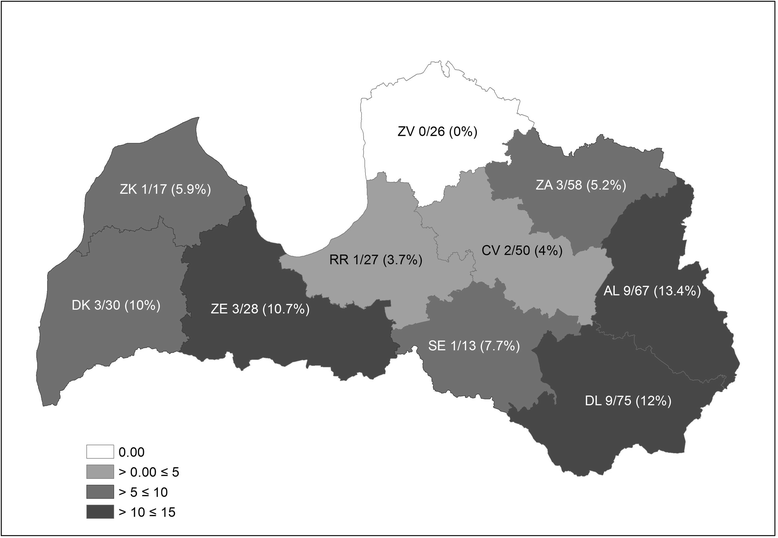Echinococcus multilocularis in foxes and raccoon dogs: an increasing concern for Baltic countries
- PMID: 27899156
- PMCID: PMC5129665
- DOI: 10.1186/s13071-016-1891-9
Echinococcus multilocularis in foxes and raccoon dogs: an increasing concern for Baltic countries
Abstract
Background: In Europe, the life-cycle of Echinococcus multilocularis is predominantly sylvatic, involving red foxes (Vulpes vulpes) as the main definitive hosts and rodents such as muskrats and arvicolids as intermediate hosts. The parasite is the etiological agent of human alveolar echinococcosis, a malignant zoonotic disease caused by the accidental ingestion of eggs shed by definitive hosts in their faeces. The aims of this study were to investigate the prevalence of E. multilocularis in red foxes and raccoon dogs (Nyctereutes procyonoides) and to study the environmental factors favouring the perpetuation of the parasite in Latvia.
Methods: A total of 538 red foxes and 407 raccoon dogs were collected across Latvia from 2010 to 2015. The sedimentation and counting technique was used for collecting E. multilocularis adult worms from fox and raccoon dog intestines. The morphological identification of the parasite was confirmed by molecular analysis.
Results: The prevalence of E. multilocularis was significantly higher in foxes (17.1%; intensity of infection 1-7,050 worms) (P < 0.001) than in raccoon dogs (8.1%; intensity of infection 5-815 worms). In foxes, a significant positive correlation (r (10) = 0.7952, P = 0.001) was found between parasite prevalence and the intensity of infection. A positive relationship (R s = 0.900, n = 5, P = 0.037) between parasite prevalence and precipitation was also observed. In raccoon dogs, a significant negative relationship (F (1,8) = 9.412, P = 0.015) between animal density and parasite prevalence, and a significant positive relationship (F (1,8) = 7.869, P = 0.023) between parasite prevalence and agricultural land cover, were detected.
Conclusions: The results of this study confirm the red fox as the most important definitive host of E. multilocularis and, consequently, as the main target for control programmes in the Baltic countries. Raccoon dogs seem to play a secondary role in the life-cycle of E. multilocularis within the investigated European region.
Keywords: Baltic countries; Echinococcus multilocularis; Latvia; Prevalence; Raccoon dog; Red fox; Zoonosis.
Figures





References
-
- Pawlowski ZS, Eckert J, Vuitton DA, Ammann RW, Kern P, Craig PS, et al. Echinococcosis in humans: clinical aspects, diagnosis and treatment. In: Eckert J, Gemmell MA, Meslin FX, Pawlowski ZS, et al., editors. WHO/OIE Manual on Echinococcosis in Humans and Animals: a Public Health Problem of Global Concern. Paris: World Health Organization; 2001. pp. 20–71.
-
- Kern P. Report of the WHO Informal Working Group on cystic and alveolar echinococcosis surveillance, prevention and control, with the participation of the Food and Agriculture Organization of the United Nations and the World Organisation for Animal Health. Geneva: World Health Organization; 2011. pp. 1–3.
-
- Keiss J, Sondore V, Cernusenko A, Viksna L, Rozentale B. Current trends in echinococcosis in Latvia. The 17th European Congress of Clinical Microbiology and Infectious Diseases (ECCMID) & 25th International Congress of Chemotherapy (ICC), Conference Proceedings. 2007. p. 122–3.
-
- Laivacuma S, Vīksne L. Case analyzes of alveolar echinococossis. Riga Stradins University Scientific Conference 2014, Abstracts. 2014. p. 184.
-
- Thompson RCA, McManus DP. Aetiology: parasites and life-cycles. In: Eckert J, Gemmell MA, Meslin FX, Pawlowski ZS, editors. WHO/OIE Manual on Echinococcosis in Humans and Animals: a Public Health Problem of Global Concern. Paris: World Health Organization; 2001. pp. 1–19.
Publication types
MeSH terms
LinkOut - more resources
Full Text Sources
Other Literature Sources

